We arrived back from our Oujda trip to find the first snow of the Ifrani year melting in our garden and a flood in our salon, or main living area.

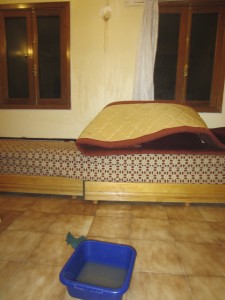
Maybe it’s time to think a little bit about heating and construction as we try for the first time to get our coal furnace to heat the house. Why, in a place that is reliably cold in winter, does no one build houses designed to stay warm as well as cold?
Housing construction in Ifrane is both fascinating and baffling on many levels. First of all, there are hundreds of empty houses; the town population expands ten-fold during the summer holidays. Many of these empty houses are second or third homes, but some just seem abandoned, used primarily for slingshot practice by teenaged boys:
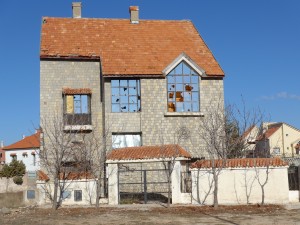
Does Ifrane really need more housing? And why are so many houses left half-finished? Part of the problem, I’m told, is the difficulty of obtaining credit, so people start to build a house, but when they run out of money, the project is put on hold until they can save up enough for the next stage of construction.
The props used to stabilize each layer of building are so different from what one would find in the United States:

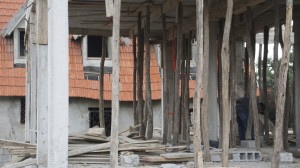
The use of stone for foundations makes sense to me…
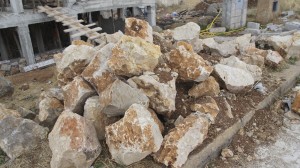
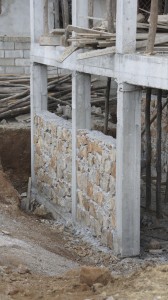
but cement blocks, or chipped brick blocks, are not going to help with the winter’s chill:
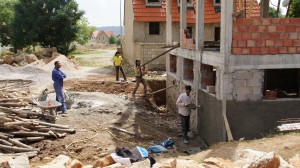
When buildings are effectively wrapped in tinfoil as an attempt at insulation, you know you’re in trouble… [photo coming]
People will say that there’s not enough wood nearby for that to be an affordable building material, but there’s certainly a lot of wood consumed in heating these uninsulated chilly cement blocks. October brought the first major deliveries of wood, mostly cedar from the surrounding mountains:
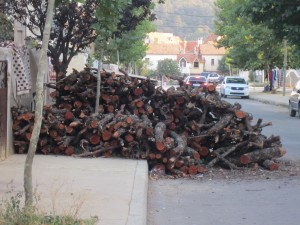
Sometimes the delivery blocks off a whole section of the street, but before long the whine of chainsaws lets you know the obstacle is about to be cleared:
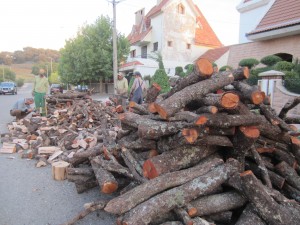
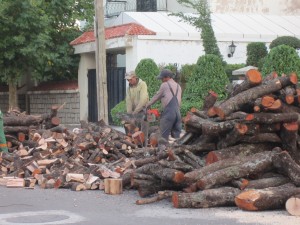
Chopped wood is carefully stacked, to be burned in stoves with pipes, leaking from right-angle turns, serving as chimneys. (It was the stove hole in our wall that led to the flood in our salon.)
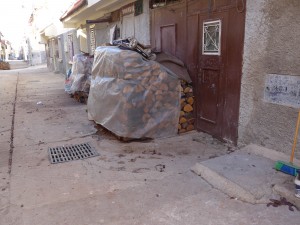
But people who don’t have money for this kind of wood take other steps to heat their homes, gathering smaller sticks in great quantities. Below, a group of women head out to the forest with their handcarts for a day of gleaning firewood, and a man carries a stack of wood home on his bike.

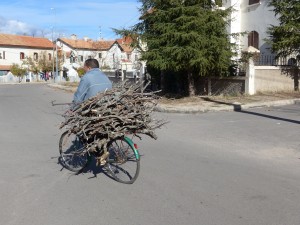
The result is a haze of smoke that hangs over the village every chilly evening: 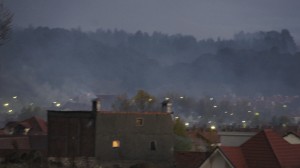
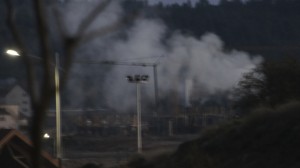
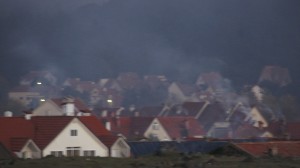
Our home is heated with coal, though the furnace is first lit with wood, so our garage is full of 1) a ton of coal and 2) some five or six bags of sweet-smelling cedar. Every time I open the door to get out my bike, I’m bowled over by the sweet fragrance, masking the dirty reality of the coal.
But with the exception of one room with extra radiators and a party wall (shared with another house), our house is very cold: the heat added by the radiators is roughly equal to the heat lost through the walls and windows. (The combination of a low furnace chimney and leaky windows also meant that we were breathing coal fumes day and night, so in fact we will be moving to house-sit for some absent friends with a gas-fired furnace until the spring arrives. Their house is also cold.) For the most part, our Moroccan friends also have one warm room they live in all winter, scuttling off to bed, then coming back to the fire as quickly as possible.
Bjorn Lomborg wrote an op-ed piece in the NYTimes on December 3rd insisting on the critical necessity of fossil fuels for the developing world. Many of his points are well-taken: “More than 1.2 billion people around the world have no access to electricity…. Most of them live in sub-Saharan Africa and in Asia. That is nearly four times the number of people who live in the United States…. [A]n estimated three billion … still cook and heat their homes using open fires and leaky stoves” and as a result, “about 3.5 million of them die prematurely each year as a result of breathing the polluted air inside their homes.”
I’m not living in sub-Saharan Africa, but my experience of North Africa leads me to disagree with at least one of Lomborg’s conclusions: “let’s face it. What those living in energy poverty need are reliable, low-cost fossil fuels, at least until we can make a global transition to a greener energy future.” It’s possible to purchase coal here in Ifrane (we did), and heating oil is still subsidized, much to the displeasure of the World Bank and the IMF. But our neighbors and friends aren’t busy purchasing coal and gas. They’re pretty firmly committed to wood stoves. I’d say they need an affordable green (and healthy) alternative to heating fuel–they also need insulation and energy conservation–but I’m not sure they’d agree.
Meanwhile, both in the desert and on the mountains, I’ve seen Imazighen people deriving electricity from solar panels (for instance) in contexts where it’s hard to see how coal or gas would offer any benefit. Urging support for coal-burning power plants (and implicitly financing an entire delivery structure based on older energy assumptions) is to ignore, for example, the way mobile phone service in Africa leapfrogged over the absence of landline infrastructure.
So rather than arguing about the benefits of fossil fuels, let’s all push for a major leap forward on green methods for energy conservation, generation, and distribution. Soon, please.